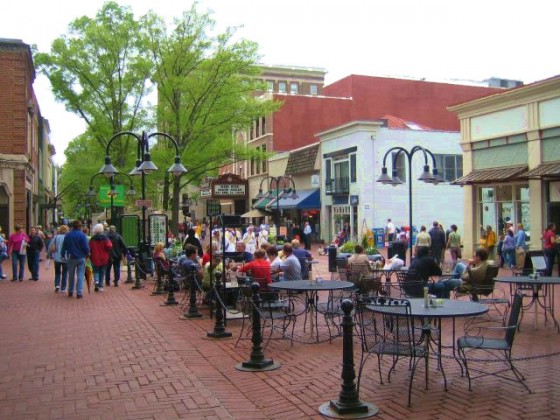How should local and national retailers mix?

It’s one of the most commonly asked questions regarding downtowns, “What should the ideal mix of local independent retailers be to regional and national chains?” First of all, let’s list two instances when chains generally aren’t appreciated.
Is your neighborhood a natural cultural district?
In other words, if the neighborhood organically developed with human-scaled buildings, often in historic districts, and already predominantly consists of local businesses, then keeping it that way not only benefits the immediate residents who prefer it as such, but provides a unique destination for visitors that want to experience the local culture. If they absolutely need to be accommodated, chains can locate in the next neighborhood over, which in a city is within walking distance.
How important is the triple bottom line to your neighborhood or district?
From an ideal triple-bottom-line viewpoint that best benefits the community economically, culturally and environmentally, it would be all locals. See “Locals have 4x economic impact over nationals“. Restaurants could source foods locally. The neighborhood would be better able to retain its own unique cultural identity, see “Keep Austin Weird“.
When are chains actually preferred?
– Scenario #1: Just about every city has a chain-store-oriented district, and that’s where they’re most appreciated. The goal is to keep these big box power centers, strip malls and corporate cultural districts distinct from the natural cultural districts.
– Scenario #2: There are a number of retail types that local indies have difficulty competing at any level. The next section lists when a chain may be more viable.
When are chains more welcome as a neighborhood option vs local indie
When selling goods that are themselves national brands. Economies of scale are difficult to compete with. However, when a local venue is able to thrive in this category, it’s viewed as an extraordinary community asset.
– Supermarkets/pharmacies vs co-op supermarkets and distributed corner grocery stores.
– Banks vs credit unions.
– Business service providers like cell phone service and shipping vs no real competitors.
When are locals most preferred?
When selling services and experiences that are tailored to the individual.
– Local restaurants, cafes and coffeehouses vs chain restaurants and fast food franchises.
– Personal services (e.g. dry cleaning, salons, gyms, yoga studios).
– Specialty retail and goods that can’t easily be found anywhere else.
Btw, try not to refer to today’s local indies as “Mom & Pops” – just do an image search and you’ll see what I mean. They’re too associated with the quaint stores that the nationals replaced decades ago because they couldn’t compete.
This entry will be continuously updated…

Leave a Reply